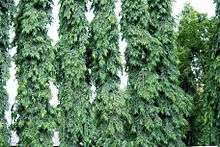Polyalthia longifolia
| Polyalthia longifolia | |
|---|---|
 | |
| Scientific classification | |
| Kingdom: | Plantae |
| (unranked): | Angiosperms |
| (unranked): | Magnoliids |
| Order: | Magnoliales |
| Family: | Annonaceae |
| Genus: | Polyalthia |
| Species: | P. longifolia |
| Binomial name | |
| Polyalthia longifolia Sonn. | |
| Synonyms[1] | |
| |

var. pendula - leaves
Polyalthia longifolia (False Ashoka) is a lofty evergreen tree, native to India, commonly planted due to its effectiveness in alleviating noise pollution. It exhibits symmetrical pyramidal growth with willowy weeping pendulous branches and long narrow lanceolate leaves with undulate margins. The tree is known to grow over 30 ft in height.
Polyalthea is derived from a combination of Greek words meaning ‘many cures’ with reference to the medicinal properties of the tree while Longifolia, in Latin, refers to the length of its leaves.[2]
Polyalthia longifolia is sometimes incorrectly identified as the Ashoka tree (Saraca indica) because of the close resemblance of both trees.
One might mistake it as a tree with effectively no branches, but in fact a Polyalthia allowed to grow naturally (without trimming the branches out for decorative reasons) grows into a normal large tree with plenty of shade.
Common names
Polyalthia longifolia's common names include False Ashoka, the Buddha Tree, Indian mast tree, and Indian Fir tree. Its names in other languages include Ashoka in Sanskrit, Unboi (উনবৈ) or Debadaru (দেৱদাৰু) in Assamese, Debdaru in Bengali and Hindi, Asopalav (Gujarati), Glodogan tiang (Indonesian), Ashok in Marathi and Nettilinkam நெட்டிலிங்கம் in Tamil, and araNamaram: അരണമരം (Malayalam). There are two important traditions associated with the tree in India (presumably in its full, untrimmed, form with spreading branches), one being of Sita taking shelter in the shade of Ashoka when in captivity (found in the Ramayana) and another that of the Ashoka tree requiring a kick from a beautiful woman on spring festival day before it would bloom (in the Malavikagnimitra, for example). However, these associations are linked to the real Ashoka tree not the false Ashoka tree (Polyalthia longifolia).
Distribution
Found natively in India and Sri Lanka. It is introduced in gardens in many tropical countries around the world. It is, for example, widely used in parts of Jakarta in Indonesia.
Leaves
Fresh leaves are a coppery brown color and are soft and delicate to touch, as the leaves grow older the color becomes a light green and finally a dark green. The leaves are shaped like a lance and have wavy edges. The leaves are larval food plant of the Tailed Jay and the Kite Swallowtail butterflies.
Flowering
_flowers_W2_IMG_7047.jpg)
In spring the tree is covered with delicate star-like pale green flowers. The flowers last for a short period, usually two to three weeks, are not conspicuous due to their color.
Fruit is born in clusters of 10-20, initially green but turning purple or black when ripe. These are loved by birds such as the Asian koel Eudynamys scolopaceus and bats including flying foxes.
Uses
The leaves are used for ornamental decoration during festivals. The tree is a main attraction in gardens throughout India. The tree can be cut into various shapes and maintained in required sizes. In past, the flexible, straight and light-weight trunks were used in the making of masts for sailing ships. That is why the tree is also known as the Mast Tree. Today, the tree is mostly used for manufacturing small articles such as pencils, boxes, matchsticks, etc. [3]
Methanolic extracts of Polyalthia longifolia have yielded 20 known and two new organic compounds, some of which show cytotoxic properties.[4]
Cited references
- ↑ The Plant List: A Working List of All Plant Species, retrieved 6 January 2016
- ↑ McCann, Charles (1959). 100 Beautiful Trees of India: A Descriptive and Pictorial Handbook. D.B. Taraporevala Sons & Co. Private Ltd. p. 32.
- ↑ "Polyalthia Longifolia The Mast Tree". The Lovely Plants.
- ↑ Chen, Chung-Yi; Fang-Rong Chang; Yao-Ching Shih; Tian-Jye Hsieh; Yi-Chen Chia; Huang-Yi Tseng; Hua-Chien Chen; Shu-Jen Chen; Ming-Chu Hsu; Yang-Chang Wu (2000). "Cytotoxic Constituents of Polyalthia longifolia var. pendula". Journal of Natural Products. 63 (11): 1475–1478. doi:10.1021/np000176e. PMID 11087586. S0163-3864(00)00176-2. Retrieved 2007-09-21.
References
- USDA, ARS, National Genetic Resources Program. Germplasm Resources Information Network - (GRIN) [Online Database]. National Germplasm Resources Laboratory, Beltsville, Maryland. (Accessed 19 July 2007)
